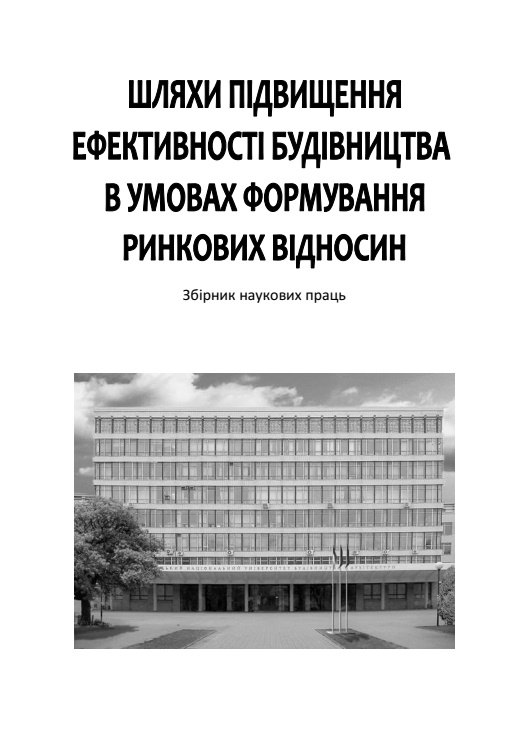Assessment of the constructability of the solutions for built-up roofs on profiled flooring with the account for the minimum thermal requirements.
DOI:
https://doi.org/10.32347/2707-501x.2019.39.78-86Keywords:
roofs, design and technology solutions, profiled flooring, labor inputs, cost, resistance to heat transfer, thermally inhomogeneous structures.Abstract
The classification of the built-up roof constructive solutions by the profiled flooring has been proposed. The field of research was limited by the following options for constructive-technological solutions: with polymer membrane roof covering; with polymer membrane roof covering and combined insulation; with two-layer roof covering and sheet-backed coat from asbestos-cement plates; with a profiled flooring roofing. The thickness of the roof insulation layer was determined as that of thermally inhomogeneous structures in accordance with the minimum requirements of DBN V.2.6-31: 2016. The labor inputs and the roofing installing cost for accepted options were determined in accordance with RECN. Based on the research findings, the option of roofing on profiled flooring with a polymer membrane covering and combined insulation has been defined as the most rational.References
ДБН В.2.6-220:2017 Покриття будівель і споруд. [Текст]: — К.: Міністерство регіонального розвитку та будівництва України, 2017. — 43 с.
ДСТУ-Н Б В.2.6-214:2016 Настанова з улаштування та експлуатації дахів будинків, будівель і споруд [Текст]: К.: ДП «УкрНДНЦ», 2017. – 45 с.
Балицкий В. С., Павлюк О. П. До питання раціонального вибору рулонних покрівельних матеріалів / Будівництво України: наук-виробн. журнал – К.: АБУ, 2004. № 7. С 35–37.
Джалалов М.Н. Анализ организационно-технологических решений устройства мягкой кровли из полимерных мембран/ М.Н. Джалалов// Науковий вісник будівництва, № 3(85) – Х.: 2016. – С. 116 – 120.
Жван В. В. Совершенствование технологии устройства и ремонта плоских кровель из рулонных битумно-полимерных материалов : автореф. дисс. на соискание науч. степени канд. тех. наук : спец. 05.23.08 «Технология и организация промышленного и гражданского строительства» / В. В. Жван. – Днепропетровск, 2003. – 19 с.
Карапузов, Є.К. Технологічні основи підвищення експлуатаційної ефективності систем гідроізоляції [Текст] : [монографія] / Є. К. Карапузов. - К. : Вища освіта, 2013. - 300 с. : іл., табл.
Лапидус А.А. Формирование организационно-технологического потенциала производства кровельных конструкций жилых многоэтажных зданий/А.А. Лапидус, А.Н. Макаров // Вестник МГСУ 2015. №8 – М.: 2015. – С. 150 – 160.
Клопунов И.С. Организационно-технологические основы повышения эффективности устройства мягких кровельных покрытий: автореф. дис... к-та техн. наук: 05.23.08 /И.С. Клопунов; Сибирская государственная автомобильно-дорожная академия. – Омск., 2000. – 21 с.:- рис. – рус.
Методи вибору теплоізоляційного матеріалу для утеплення будівель: ДСТУ Б В.2.6-189:2013 – [Чинний від 2014-01-01]. – К.: Мінрегіонбуд України, 2014. – 46 с. – (Національний стандарт України).
Теплова ізоляція будівель. ДБН В.2.6-31:2016. [Чинні від 2017-05-01]. – К.:Мінрегіонбуд України, 2017. – 33 с. – (Національний стандарт України).
Downloads
How to Cite
Issue
Section
License

This work is licensed under a Creative Commons Attribution 4.0 International License.
Authors who publish with this journal agree to the following terms:
- Authors retain copyright and grant the journal right of first publication with the work simultaneously licensed under a Creative Commons Attribution License that allows others to share the work with an acknowledgement of the work's authorship and initial publication in this journal.
- Authors are able to enter into separate, additional contractual arrangements for the non-exclusive distribution of the journal's published version of the work (e.g., post it to an institutional repository or publish it in a book), with an acknowledgement of its initial publication in this journal.
- Authors are permitted and encouraged to post their work online (e.g., in institutional repositories or on their website) prior to and during the submission process, as it can lead to productive exchanges, as well as earlier and greater citation of published work (See The Effect of Open Access).

